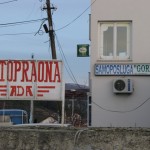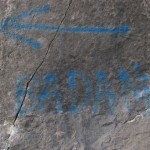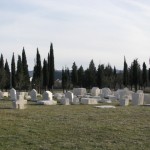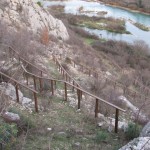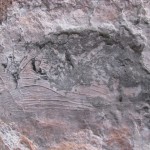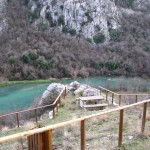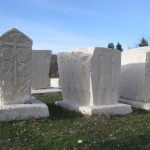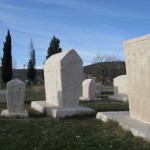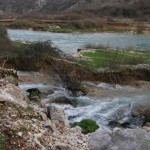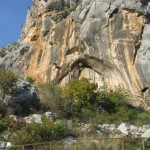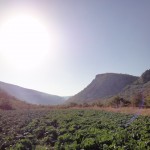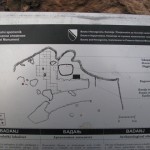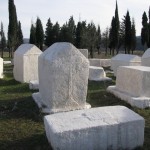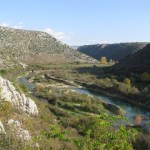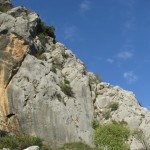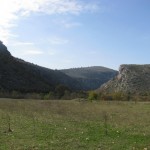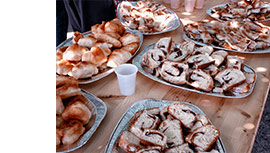(english version)
(wersja polska)
(Version française)
Nekropola stećaka Radimlja nalazi se u Vidovu polju, oko 3,3 km zapadno od Stoca, na putu Čapljina – Stolac.
Nekropola na Radimlji spada među nekoliko najvrijednijih i najznačajnijih nekropola Bogumila – pripadnika Bosanske crkve. Najstariji nadgrobni spomenici su iz XV. i XVI. stoljeća o čemu svjedoče natpisi na jednom od spomenika koji pripada tadašnjim gospodarima ove zemlje, obitelji Hrabren-Miloradović.
Za vrijeme vladavine Austro-Ugarske Monarhije izgrađena je cesta koja je povezala Čapljinu i Stolac a koja je presjekla Nekropolu na dva djela, ostavljajući na sjevernoj strani 11 stećaka te na južnoj 122. Vjeruje se da je tokom izgradnje ceste uništeno oko 20 stećaka.
Ako imate želju posjetiti pećinu Badanj, trebate ići prema Stocu. Nakon oko 1 km vožnje treba skrenuti desno, prije samoposluge „Gorica” te ići dalje glavnom asfaltnom cestom među zgradama. Zatim, nakon 1,1 km, sa lijeve strane počne makadamska cesta koja ide u dolinu. Pazite! Nakon obilnih kiša na cesti ima puno dubokih lokava tako da je bolje ostaviti auto na početku makadama.
Put vodi uzduž Bregave. Na početku se može vidjeti polja prokulica i brokula. Bliže špilje dolina postaje šira, te Bregava stvara prelijepe močvare.Od početka makadamske ceste do pećine ima oko 4 km.
Zadnjih nekoliko metara ide se stazom uzbrdo. Staza je označena i zaštićena ogradom, može se također slobodno sjesti na klupama uzduž nje. Špilja i stijena s prapovijesnim crtežima iz 14-10 tis. godina prije Krista prave veliki dojam, dominirajući iznad doline. Imate tamo također prekrasan pogled na močvare i okolna brda.
Necropolis Radimlja is located in Vidovo Polje, about 3.3 km west of Stolac, on the way Čapljina – Stolac.
Necropolises on Radimlja are among the few most valuable and most important necropolises of Bogomil – members of the Bosnian Church. The oldest gravestones are from the XV° and XVI° centuries, as show one of the inscriptions on the monuments belonging to the ruler of this land, the Hrabren Miloradović family.
During the rule of the Austro-Hungarian Empire, they built the road linking Capljina and Stolac, that cut through Necropolis, leaving the north side with 11 tombstones, and on the south 122. It is believed that during the construction of road 20 tombstones were destroyed.
If you have the desire to visit the Badanj cave, you need to take the road to Stolac. After about 1 km turn right before “Gorica” store, and go on the main paved road between the buildings. Then, after 1.1 km, starting on the left you’ll enter a gravel road that goes into the valley. Watch out! After heavy rain the road has a lot of deep puddles so it's better to leave the car at the start of the gravel road.
The path runs along the Bregava River. At first, you may see fields Brussels sprouts and broccoli. Closer to the cave valley becomes wider, and creates beautiful Bregava swamp .From the start of the dirt road to the cave is about 4 km.
Last few meters of the trail goes uphill. The path is marked and protected by the fence, you can also feel free to sit on benches along it. Caves and rock with prehistoric drawings from 14-10 thousand years before Christ, makes true big impression, dominating over the valley. There also is a beautiful view of the surrounding hills and swamps.
(wersja polska)
Nekropolia Radimlja znajduje się bezpośrednio przy drodze Stolac-Čaplijna/Mostar w odległości ok. 3,3 km od Stolac.
Radimlja jest uważana za największą i najwspanialszą nekropolię Bogomiłów – członków Kościoła Bośniackiego. Najstarsze kamienne nagrobki nazywane stećci, pochodzą z XV i XVI wieku o czym świadczą napisy na jednym z nich, należącym do władców tych ziem rodziny Hrabren-Miloradović.
Podczas budowy drogi Čaplijna-Stolac za czasów austrowęgierskich 11 nagrobków zostało po prawej (jadąc od Stolac), 122 po lewej stronie drogi. 20 uległo niestety zniszczeniu.
Aby dostać się do jaskini Badanj należy z Radimlji kierować się w stronę Stolac. Po przejechaniu ok. kilometra, przed sklepem samoobsługowym „Gorica” (Samoposluga „Gorica”), należy skręcić w prawo. Następnie jechać główną ulicą asfaltową, która prowadzi wąsko między zabudowaniami. Po przejechaniu ok. 1,1 km trafimy na drogę szutrową odchodzącą w lewo w głąb doliny. Należy w nią skręcić i przy najbliższej możliwość zostawić auto. Po opadach deszczu, na drodze tworzą się ogromne, głębokie kałuże, dlatego zdecydowanie nie polecamy pokonywanie reszty drogi autem.
Droga do jaskini prowadzi w dolinie, cały czas wzdłuż rzeki Bregava. Na początku mijamy pola uprawne brukselki i brokułów. Im bardziej zbliżamy się do jaskini, tym dolina staje się szersza, a Bregava tworzy przepiękne rozlewiska. Od początku drogi szutrowej do jaskini jest ok. 4 km.
Ostatnie metry pokonujemy ścieżką w górę. Jest ona dobrze oznaczona i zabezpieczona barierkami, a po drodze ustawiono ławki.
Jaskinia i głaz z prehistorycznymi rysunkami pochodzącymi z okresu 14-10 tyś. lat p.n.e. góruje nad całą doliną. Z tego miejsca roztacza się wspaniały widok na rozlewiska Bregavy i okoliczne wzgórza.
(Version française)
La nécropole Bogomile de Radimlja est située à Vidovo Polje, environ 3,3 km à l’Ouest de Stolac, sur la route de Čapljina.
La nécropole de Radimlja compte parmi les plus importants vestiges de la religion Bogomile – members of the Bosnian Church. Les tombes les plus anciennes datent des XV° et XVI° siècles, comme le montre l’une des inscriptions présente sur une tombe appartenant au gouverneur de ces terres, de la famille Hrabren Miloradović.
Pendant la domination de l’Empire Austro-Hongrois fut construite la route reliant Stolac à Čapljina, coupant à travers la nécropole, laissant 11 tombes au Nord, et 122 au Sud. On pense que furent détruits une vingtaines de sépultures pendant la construction de la route.
Si vous désirez visiter la grotte préhistorique de Badanj, vous devez prendre la direction de Stolac. Après un 1km, tournez à droite juste avant le magasin Gorica, et suivez la route pavée entre les maisons. Après 1,1 km, sur votre gauche empruntez le sentier qui entre dans la vallée. Attention ! Après les jours de pluie de nombreux nid-de-poule se forment, il est recommandé de laisser la voiture à l’entrée du sentier et de continuer à pied.
Le chemin suit la rivière Bregava. Vous pourrez y voir des cultures de choux de Bruxelles, de brocolis et d’aubergines. Le chemin et la vallée deviennent plus sauvages à mesure que vous approcherez de la grotte, offrant de magnifiques paysages de canyon. Environ 4km sont à parcourir depuis le début du sentier rocailleux jusqu’à la grotte.
Les derniers mètres jusqu’à la grotte montent rudement. Le chemin est indiqué et protégé par des rampes de bois, et vous pouvez vous reposer sur des tables de pique-nique disposées à cet effet. La grotte et les pierres figurant des gravures préhistoriques (de 14 à 10 000 ans av. J.C) sont assez impressionnantes, dominant le canyon de la Bregava.

